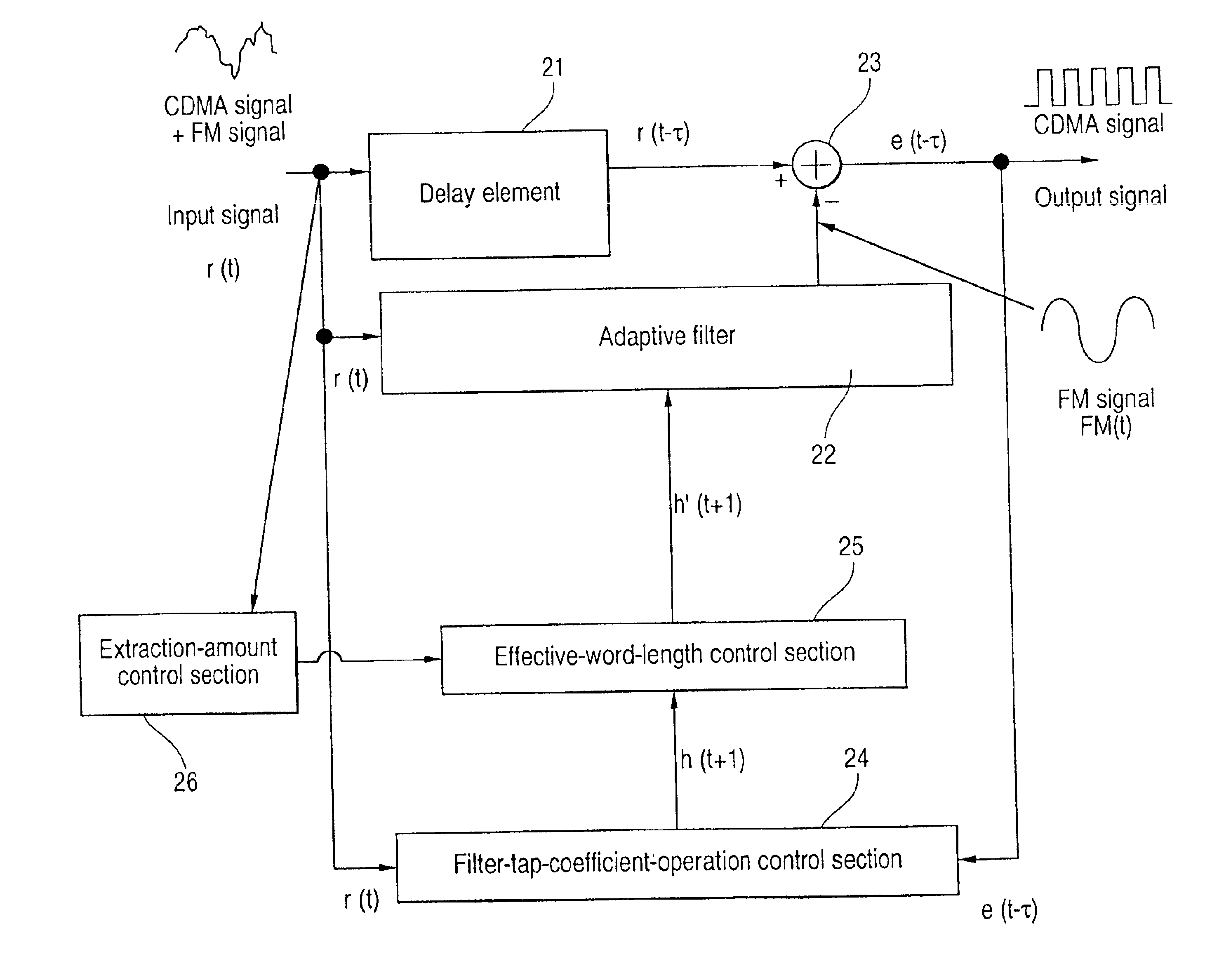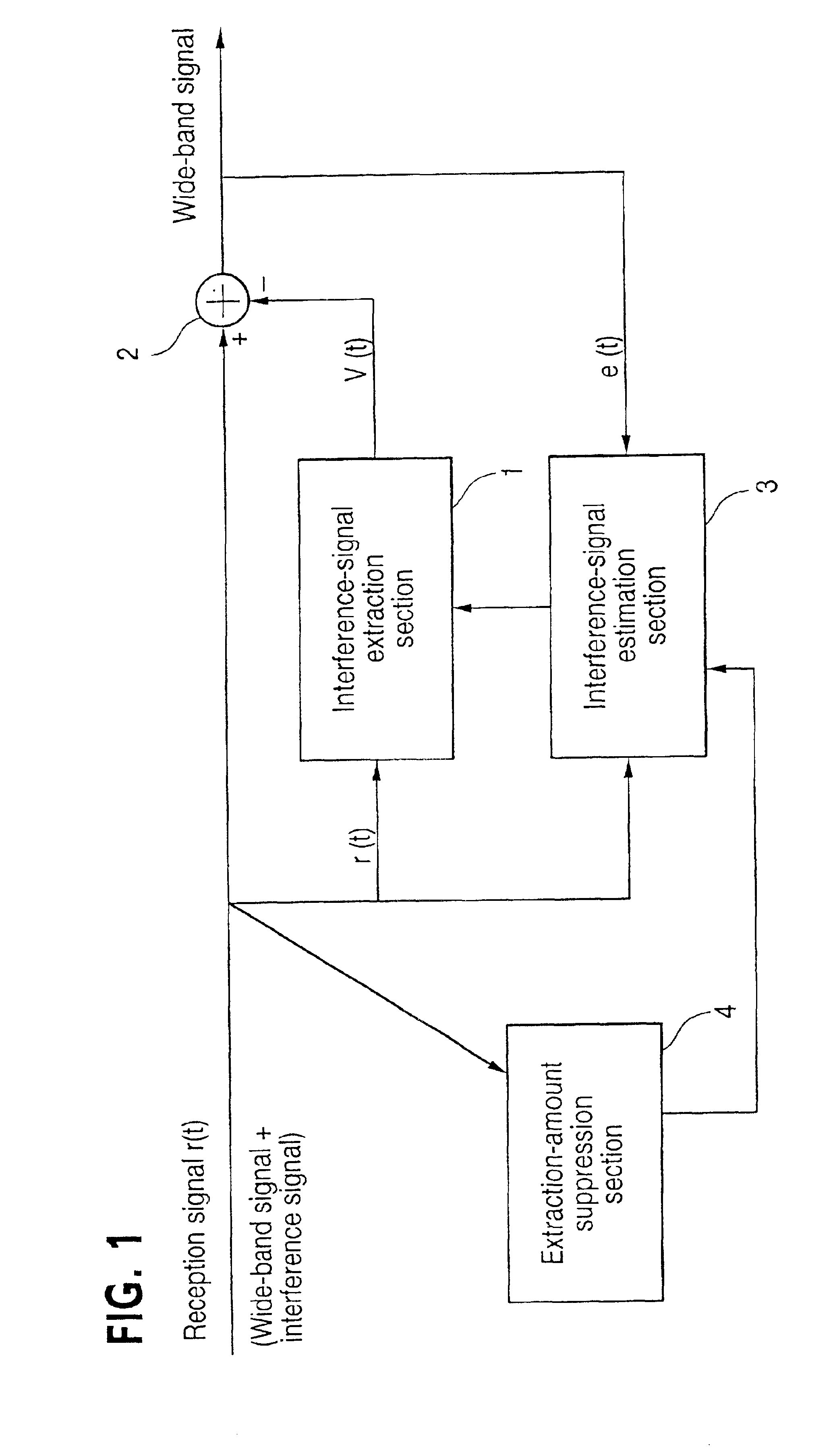Interference-signal removing apparatus
a signal removal and interference technology, applied in the direction of amplitude demodulation, line-faulst/interference reduction, pulse technique, etc., can solve the problem of deteriorating the bit error ratio of the reception signal, attenuation of the cdma component in the reception signal, and in accordance with the attenuation progress, so as to improve the characteristic of the input signal and remove interference
- Summary
- Abstract
- Description
- Claims
- Application Information
AI Technical Summary
Benefits of technology
Problems solved by technology
Method used
Image
Examples
first embodiment
[0219]First, an interference-signal removing apparatus of first embodiment of the present invention is described below.
[0220]FIG. 2 shows an interference-signal removing apparatus which is provided with an interference-signal extraction section 11, a synthesizer 12, an interference-signal estimation section 13, and an estimation-accuracy control section 14. Symbol t denotes time.
[0221]The interference-signal estimation section 13 inputs a reception signal r(t) in which a wide-band desired signal and a plurality of narrow-band interference signals are synthesized and the reception signal e(t) after interference is removed, estimates interference signals included in the reception signal r(t) by using a general adaptive algorithm, and calculates the interference-signal estimation coefficient h(t+1) in accordance with the estimation result. Moreover, the interference-signal estimation section 13 of this embodiment restricts the effective word length of the calculated interference-signal...
second embodiment
[0244]Then, an interference-signal removing apparatus of second embodiment of the present invention is described below.
[0245]Because the interference-signal removing apparatus of this embodiment has the same configuration as the apparatus shown in FIG. 2, it is described by referring to FIG. 2 in the case of this embodiment for convenience' sake of description.
[0246]As shown in FIG. 2, the interference-signal removing apparatus of this embodiment is provided with an interference-signal extraction section 11, a synthesizer 12, an interference-signal estimation section 13, and an estimation-accuracy control section 14. Symbol t denotes time.
[0247]In this case, configurations and operations of the interference-signal extraction section 11 and synthesizer 12 are the same as those shown for the above first embodiment.
[0248]To calculate an interference-signal estimation coefficient h(t+1) according to an estimation result of an interference signal similarly to the case of the first embodi...
third embodiment
[0266]Then, an interference-signal removing apparatus of third embodiment of the present invention is described below.
[0267]Because the interference-signal removing apparatus of the third embodiment has the same configuration as the apparatus shown in FIG. 2, this embodiment is described by referring to FIG. 2 for convenience's sake of description.
[0268]As shown in FIG. 2, the interference-signal removing apparatus of this embodiment is provided with an interference-signal extraction section 11, a synthesizer 12, an interference-signal estimation section 13, and an estimation-accuracy control section 14. Symbol t denotes time.
[0269]In this case, configurations and operations of the interference-signal extraction section 11 and synthesizer 12 are the same as the case of the first embodiment.
[0270]To calculate an interference-signal estimation coefficient h(t+1) according to an estimation result of an interference signal similarly to the case of the first embodiment, the interference-...
PUM
 Login to View More
Login to View More Abstract
Description
Claims
Application Information
 Login to View More
Login to View More - R&D
- Intellectual Property
- Life Sciences
- Materials
- Tech Scout
- Unparalleled Data Quality
- Higher Quality Content
- 60% Fewer Hallucinations
Browse by: Latest US Patents, China's latest patents, Technical Efficacy Thesaurus, Application Domain, Technology Topic, Popular Technical Reports.
© 2025 PatSnap. All rights reserved.Legal|Privacy policy|Modern Slavery Act Transparency Statement|Sitemap|About US| Contact US: help@patsnap.com



